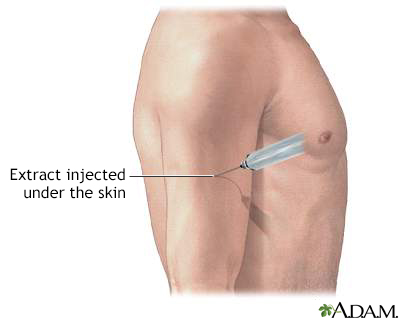Lepromin skin test
Leprosy skin test; Hansen disease - skin test
The lepromin skin test is used to determine what type of leprosy a person has.
Images

I Would Like to Learn About:
How the Test is Performed
A sample of inactive (cannot cause infection) leprosy-causing bacteria is injected just under the skin, often on the forearm, so that a small lump pushes the skin up. The lump indicates that the antigen has been injected at the correct depth.
The injection site is labeled and examined 3 days, and again 28 days later to see if there is a reaction.
How to Prepare for the Test
People with dermatitis or other skin irritations should have the test performed on an unaffected part of the body.
If your child is to have this test performed, it may be helpful to explain how the test will feel, and even demonstrate on a doll. Explain the reason for the test. Knowing the "how and why" may reduce the anxiety your child feels.
How the Test will Feel
When the antigen is injected, there may be a slight stinging or burning. There may also be mild itching at the site of injection afterward.
Why the Test is Performed
Leprosy is a long-term (chronic) and potentially disfiguring infection if left untreated. It is caused by Mycobacterium leprae bacteria.
This test is a research tool that helps classify the different types of leprosy. It is not recommended as the main method to diagnose leprosy.
Normal Results
People who don't have leprosy will have little or no skin reaction to the antigen. People with a particular type of leprosy, called lepromatous leprosy, will also have no skin reaction to the antigen.
What Abnormal Results Mean
A positive skin reaction may be seen in people with specific forms of leprosy, such as tuberculoid and borderline tuberculoid leprosy. People with lepromatous leprosy will not have a positive skin reaction.
Risks
There is a very small risk for an allergic reaction, which may include itching and rarely, hives.
Related Information
LeprosyChronic
References
Dupnik K. Leprosy (Mycobacterium leprae). In: Bennett JE, Dolin R, Blaser MJ, eds. Mandell, Douglas, and Bennett's Principles and Practice of Infectious Diseases. 9th ed. Philadelphia, PA: Elsevier; 2020:chap 250.
James WD, Elston DM, Treat JR, Rosenbach MA, Neuhaus IM. Hansen disease. In: James WD, Elston DM, Treat JR, Rosenbach MA, Neuhaus IM, eds. Andrews' Diseases of the Skin. 13th ed. Philadelphia, PA: Elsevier; 2020:chap 17.
BACK TO TOPReview Date: 8/26/2023
Reviewed By: Jatin M. Vyas, MD, PhD, Associate Professor in Medicine, Harvard Medical School; Associate in Medicine, Division of Infectious Disease, Department of Medicine, Massachusetts General Hospital, Boston, MA. Also reviewed by David C. Dugdale, MD, Medical Director, Brenda Conaway, Editorial Director, and the A.D.A.M. Editorial team.

Health Content Provider
06/01/2025
|
A.D.A.M., Inc. is accredited by URAC, for Health Content Provider (www.urac.org). URAC's accreditation program is an independent audit to verify that A.D.A.M. follows rigorous standards of quality and accountability. A.D.A.M. is among the first to achieve this important distinction for online health information and services. Learn more about A.D.A.M.'s editorial policy, editorial process and privacy policy. A.D.A.M. is also a founding member of Hi-Ethics. This site complied with the HONcode standard for trustworthy health information from 1995 to 2022, after which HON (Health On the Net, a not-for-profit organization that promoted transparent and reliable health information online) was discontinued. |
The information provided herein should not be used during any medical emergency or for the diagnosis or treatment of any medical condition. A licensed medical professional should be consulted for diagnosis and treatment of any and all medical conditions. Links to other sites are provided for information only -- they do not constitute endorsements of those other sites. © 1997- 2025 A.D.A.M., a business unit of Ebix, Inc. Any duplication or distribution of the information contained herein is strictly prohibited.
